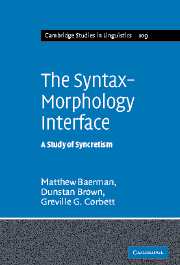Book contents
- Frontmatter
- Contents
- Preface
- List of abbreviations and symbols
- 1 Introduction
- 2 Characteristics of syncretism
- 3 Cross-linguistic typology of features
- 4 Formal representation
- 5 Formal framework and case studies
- 6 Conclusion
- Appendix 1 Case syncretism in the World Atlas of Language Structures sample
- Appendix 2 Person syncretism in the World Atlas of Language Structures sample
- Appendix 3 Syncretism in two-place verbs in the World Atlas of Language Structures corpus
- Appendix 4 DATR fragment for Dhasaanac case study
- Appendix 5 DATR fragment for Dalabon case study
- Appendix 6 DATR fragment for Russian case study
- References
- Author index
- Language index
- Subject index
3 - Cross-linguistic typology of features
Published online by Cambridge University Press: 22 September 2009
- Frontmatter
- Contents
- Preface
- List of abbreviations and symbols
- 1 Introduction
- 2 Characteristics of syncretism
- 3 Cross-linguistic typology of features
- 4 Formal representation
- 5 Formal framework and case studies
- 6 Conclusion
- Appendix 1 Case syncretism in the World Atlas of Language Structures sample
- Appendix 2 Person syncretism in the World Atlas of Language Structures sample
- Appendix 3 Syncretism in two-place verbs in the World Atlas of Language Structures corpus
- Appendix 4 DATR fragment for Dhasaanac case study
- Appendix 5 DATR fragment for Dalabon case study
- Appendix 6 DATR fragment for Russian case study
- References
- Author index
- Language index
- Subject index
Summary
Although the theoretical interest implicit in inflectional syncretism has been recognized for some time, the range of languages that have contributed to its study has remained limited. The notion was first applied to Indo-European languages, and it is from these that the bulk of examples has been drawn. Languages from other families have been brought to bear in theoretically or typologically oriented works, but to a lesser extent, e.g. Afro-Asiatic (Carstairs 1987, Fradkin 1991, Johnston 1997, Noyer 1997), Uralic (Bátori 1990, McCreight and Chvany 1991, Kiparsky 2001, Blevins 2003), Tibeto-Burman (Gvozdanović 1991), Altaic (Carstairs 1987), and more broadly defined, languages of the Caucasus (Hjelmslev 1935–7, Boeder 1976, Carstairs 1987, Carmack 1997, Kibrik 1997, Helmbrecht 1999), of Australia (Zaliznjak 1973, Goddard 1982, Bavin and Shopen 1987, Heath 1991, Noyer 1997, Evans, Brown and Corbett 2001), of the Americas (Boeder 1976, Hewson 1989, Heath 1998, Lakämper and Wunderlich 1998, Harbour 2003), of Siberia (Kibrik 1997, Spencer 2000) and New Guinea (Kibrik 1997, Noyer 1998, Wunderlich 2001b). However, these works address at most several languages. Cross-linguistic studies relevant to syncretism are rare: Cysouw (2003) is a comprehensive treatment of the morphological and lexical expression of pronominal features (person and number), while Arkadiev (2003) discusses case syncretism.
Thus, there remains a real gap in our empirical understanding of syncretism, which the following chapter should begin to redress. We have gathered examples from a wide range of languages.
Information
- Type
- Chapter
- Information
- The Syntax-Morphology InterfaceA Study of Syncretism, pp. 37 - 125Publisher: Cambridge University PressPrint publication year: 2005
